Microsoft (Bing) has its own native advertising solutions for brands to engage in PPC (pay-per-click) digital marketing, enabling them to reach new audiences across the vast Microsoft scope. This can be the ideal solution for those looking at native advertising platforms, but are hoping to spend less (or approach a less competitive area) than they would with Google ads.
Microsoft Audience Ads is an advertising solution with which you can take a step towards expanding your reach. This article looks at the best practices of Bing Ads audience targeting used by our Bing ads agency to apply to your PPC strategy.
What are Audience Ads?
Audience Ads on Microsoft (formerly Bing Ads) are a form of digital advertising that are designed to help brands (both B2B and B2C) reach new audiences, improve their SEO ranking, enhance the level of traffic coming to their websites, and ultimately generate and convert leads into profitable clients.

How it works is the platform uses AI to extract data from internet-users to then group them into audiences based on information you input into the campaign-building process. This allows you to home in on audiences that will benefit from whatever product or service you are advertising (AKA, ‘hot leads’), instead of your campaign just getting lost in the ether of the web. When executed properly, Audience Ads can be very profitable for a brand, and will certainly see a ROI (return on investment).
The user data extracted is typically demographic information, as well as browser behaviour. When running an Audience Ad, you have two options:
- You can extend existing ‘Search’ campaigns with image ad extensions and audience ads bid adjustments.
- You can separate your budgets, ads, and bids from ‘Search’ campaigns.
How to Set Up an Audience Ads Campaign
If you’re new to Microsoft Advertising, here’s how to get started with your first Audience Ads campaign and the options available to you:
Location Targeting
You will be asked where you want your campaign to be advertised to:
- Canada or the United States
- All available countries/regions
- Let me choose specific locations
However, if you would like a more specific targeting option, you can do so by focusing on postal/zip code. The default selection will be where in the world you are based.

Audience Targeting
This also includes:
- Customer match audiences.
- Remarketing audiences (to refocus on those already familiar with your brand/past customers).
- Product audiences.
- Similar audiences.
- All Microsoft in-market audiences (to target audiences who haven’t used your brand before).
The option you choose depends on what type of campaign you wish to run, what the desired outcome is, and what you’re advertising (and to whom).

Age Targeting
Here are the age range options available on Microsoft Advertising:
- 18 – 24
- 25 – 34
- 35 – 49
- 50 – 64
- 65+
- Unknown
Please note: Microsoft has a default option, which is all age groups will be ticked, so be mindful of this if you are targeting a specific age group only.
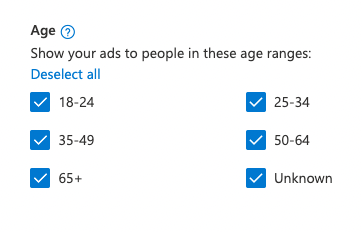
Gender Targeting
Here are the gender options:
- Male
- Female
- Unknown
Naturally, some ads can be more geared towards specific genders, but as with the age targeting option, the default option will be all three of the above.
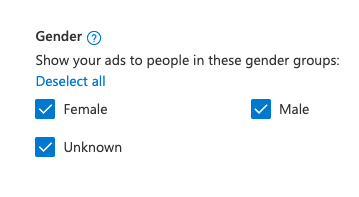
LinkedIn Profile Targeting
This may be viable only to B2B brands, but not exclusively. With LinkedIn profile targeting, you are able to extract LinkedIn member data as a ‘targeting only’ option. This means you can aim your campaign at specific companies or certain individuals in certain industries, as well as what their role or ranking is within this industry.
Here’s a breakdown on LinkedIn Profile Targeting:
Company Targeting
While this allows you to be relatively specific when targeting companies, it is worth bearing in mind that not all LinkedIn members regularly update their profile information, so there is a chance that this type of targeting may not be 100% reliable. That said, it is still a viable option and shouldn’t be disregarded as a potentially lucrative source of audience building.
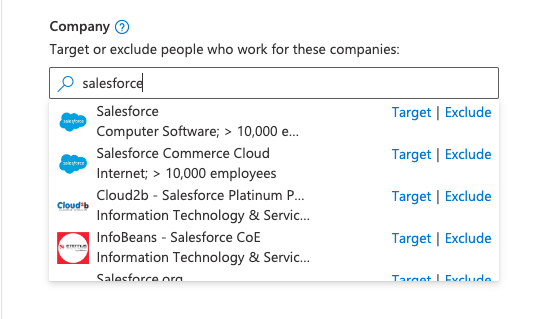
Industry Targeting
If you don’t want your targeting to be as specific as company targeting, industry targeting may be the better solution. Also, you will find that all the specific industries listed on LinkedIn allow you to home in on more pinpointed sectors of each.

Job Function Targeting
Again, if you prefer broader targeting, then job function targeting caters to that because you can target per ‘type’ of job, for example, the marketing teams of the healthcare industry, and so on.

Creating Your First Audience Ad
For your Audience Ad, you will need to add a suitable image/s. Once you have selected one (you will need to upload it), the platform will then show you how this image will look to your leads once your campaign goes live, allowing you to crop, edit, remove, and so on.
Once this is done, you can then add your ad copy, website URL, and business name. Be aware that their are character limits:
- Business name: up to 25 characters long
- Ad text: up to 90 characters long
- Long headline: up to 90 characters long
- Short headline: up to 25 characters long
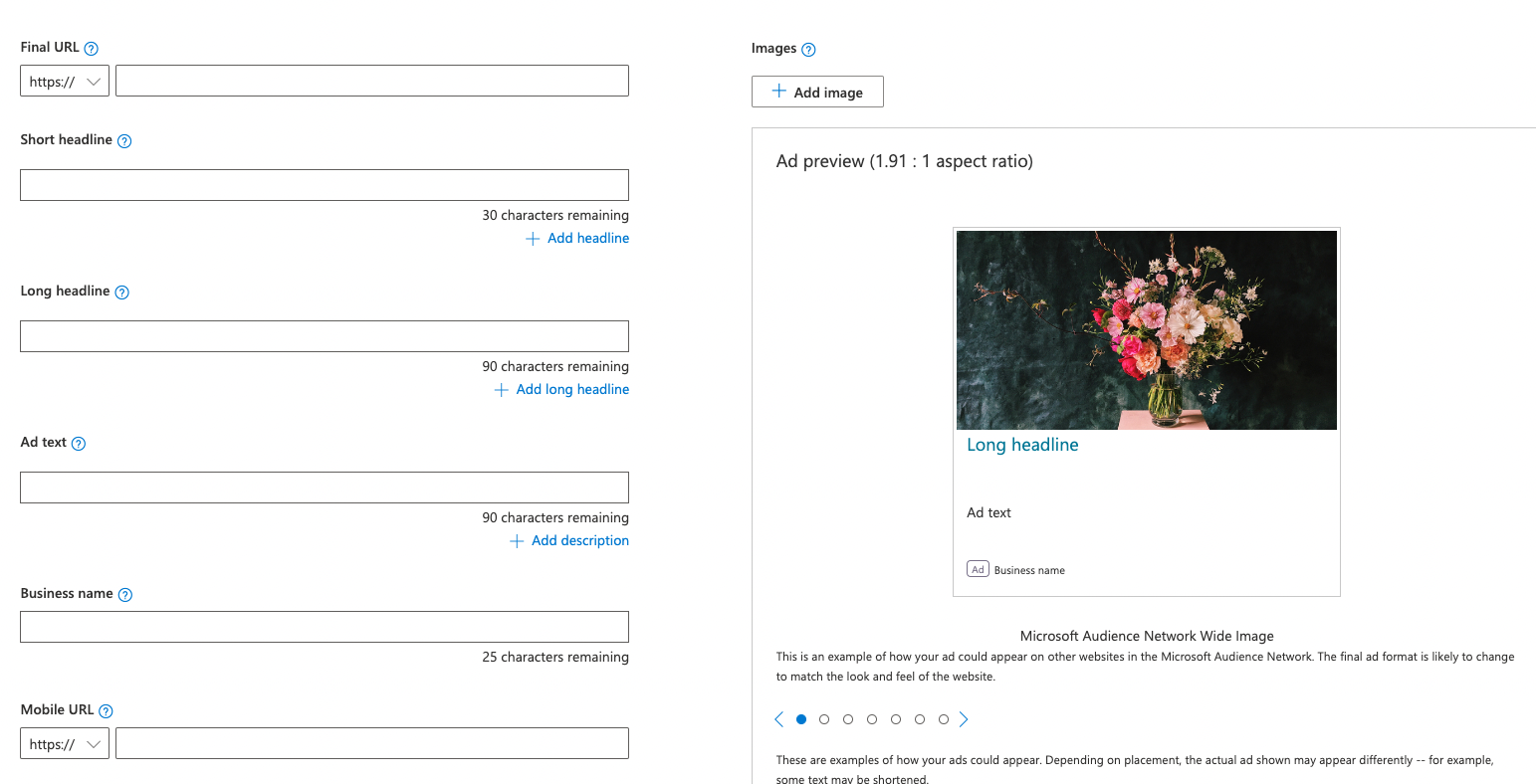
Once this information is all correctly implemented, you can then use Microsoft Audience Network to view how the campaign looks. This ad preview allows you to see your work through the eyes of a lead, and make any necessary amendments.
Budgets & Bidding
Now is the financial part of the process. Enter the desired bid amount for your ad and the platform will provide you an estimation based on your budget and bid amount. This will be based on monthly clicks, monthly impressions, potential CTR, CPC averages, and your monthly spend. This is not cast in stone, however. You are able to adjust and amend budget and bidding now and later on when your campaign is live.
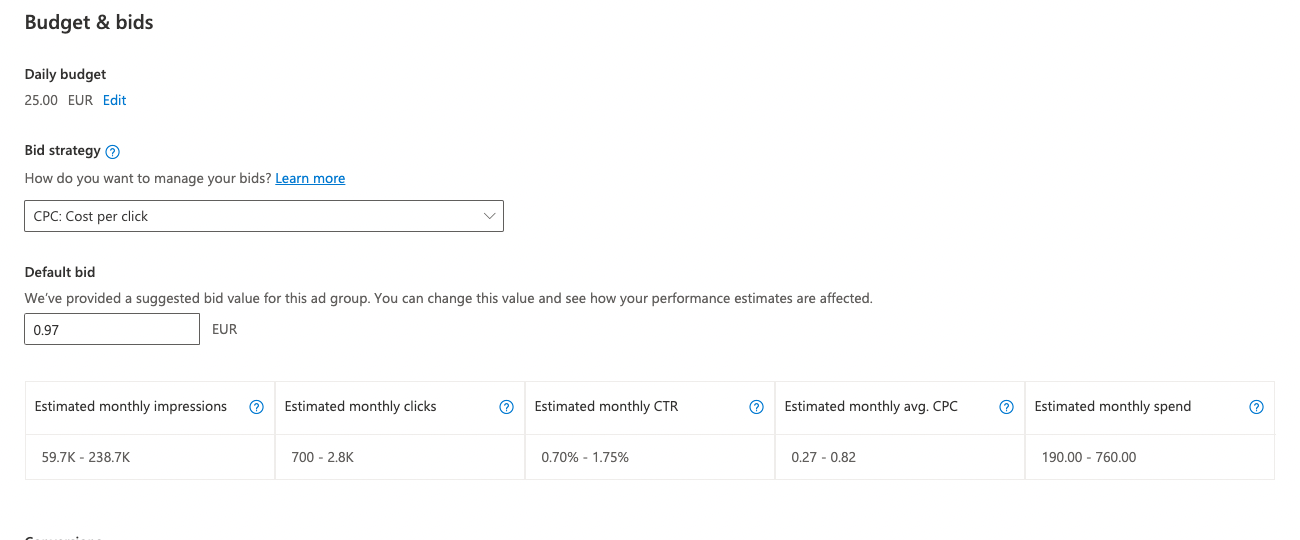
You can also make bid adjustments to any of the targeting options you have added to your ad group, and then set your ad schedule. Once you have inputted all of this information, click ‘Save’.
It can be wise to do some testing before your ad goes live to ensure you’re hitting the mark. This can provide crucial information where amendments are needed within your campaign, which could ultimately garner a much more fruitful return-on-investment.
Best Practices for Audience Ads
To get the best out of the work you have put into your campaign, here are some useful tips:
- Invite a higher volume of engagements by extending your campaign/s across different device types, or by running mobile-only campaigns (if your ads are targeting, for example, commuters).
- Use combinations of multiple audiences and audience types to reach the ‘warmest’ leads. Keep in mind that you can associate audiences at both the ad-group and the campaign level.
- Look into other campaign types. Audience targeting can be used for all different ad types, so don’t stick with one for all your campaigns, just because it is familiar.
- Be bold with your bidding. This means looking into a broader range of keywords and phrases and bidding on them to maximise your campaign’s outreach. Being broad with bidding but finely-honed on your audience is a winning combination.
- Also be broad with your match types. This will help you reach a wider (but still relevant) audience.
- Consider ad customisers. This will allow your ads to update themselves when targeting your built audiences.
Conclusion
Native platform advertising on search engines that aren’t Google can mean less competition and lower bid costs, but because Microsoft has vast exposure across its channels, utilising it to create Audience Ads can considerably up your digital marketing game to generate and convert the right leads for your brand by giving your campaign great visibility.
If you’d like to learn more about how we help B2B SaaS and Tech companies grow their MRR through Bing ads, contact us online or send us an email today at info@getuplead.com to speak with someone on our team.
You might also be interested:


